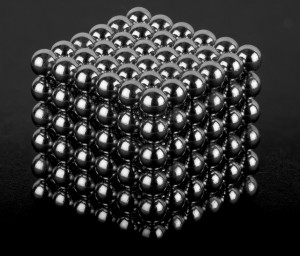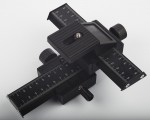
My friend David very kindly gave me a cute toy for the Solstice — a set of Neodymium spherical magnets marketed as the NeoCube — they’re fairly small but extremely powerful. Once one gets over being able to have a handful of ball-bearings that don’t go flying off in all directions,the obvious use is for still life exercises. One can make rather amazing structures as the photo demonstrates, and the videos on the company’s website are an entree to endless hours of frustration.
So anyway it’s a nice difficult subject to light and photograph. highly polished spherical items. I had fun with soft-boxes, and black and white foam boards till I got a set of reflections that I liked, Then the fun begins, to try to photograph it. The image will only be in focus for very slightly more than a hemisphere at F11 with a full set of macro tubes. I’ll be making a later post with some good links about circles of confusion, hyperfocal distance and the digital vs film non-issue triggered by thinking about this.
The photo above is a composite of 12 frames loaded into separate layers with the focus slowly advancing from the nearest sphere to the furthest corners. I worked my way down the stack by hand erasing the out-of focus further content just to prove one can do it ‘by hand’. It’s noticeable that the shape of the image changes slightly as the focus moves back, even though the camera has not moved, only the lens elements.

The next part of the exercise is the same subject, but with an extra softbox. A simmilar set of 12 frames, but this time I let photoshop CS4 take the strain, and used the auto-merge feature (Edit Menu, under Auto-Align — select the layers first). Frankly it did a better job than I have patience for in 5 minutes, rather than the 3 hours it took by hand. Vorsprung durch Technik (qv), in the phrase made famous by some car advert. Some of the strips of image it built would have been difficult by hand, and of course the automatic builder makes no assumptions about the ordering of one’s layers, so masks out all the unwanted stuff on every layer.
The common factor on both these images is that the camera has been stationary, and one had focused using the focus ring on the lens, and resisted any temptation to focus with the zoom control, as one is usually tempted to do when using the macro rings “in the wild.”

The final photograph is taken again on the tripod, but this time one is using a Macro slider to move the focus by very precise, even amounts. It is relatively quick to move the camera by a short distance (3mm in this case) between frames, rather than worrying about visible focus for each shot. In this case the composite has better overall alignment without as much of the distortion that seemed to pull out the far corners. Overall the Gizmo seems to do a better job.

What good value unbranded accessories are from E-Bay! it’s particularly true where one is looking at purely mechanical engineering, such as the Macro rail here. This one came from an E-Bay trader ‘phoebe-g’ but seems to be generally availble from a number of traders.
Related Posts
- Macro and short depth of field
- For want of a nail — a belated review of the TrekPod Go
- Help my menu settings keep vanishing!
- So… What is “Pro” a code for?
- Photo Selection Slideshows
- Eye-Fi vs Shooting Tethered
- YN565 E-TTL Flash Speedlite fails with Canon ST-E2
- Another Speedlight replacement
- Seasonal Toys & Games
- Pixel Wired Off-Camera Extender
- Tethering (Continued)
- New 5D3 with BG-E11, unboxing and first impressions
